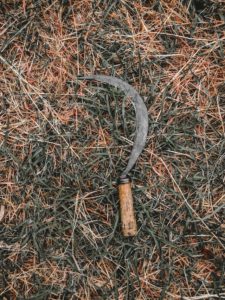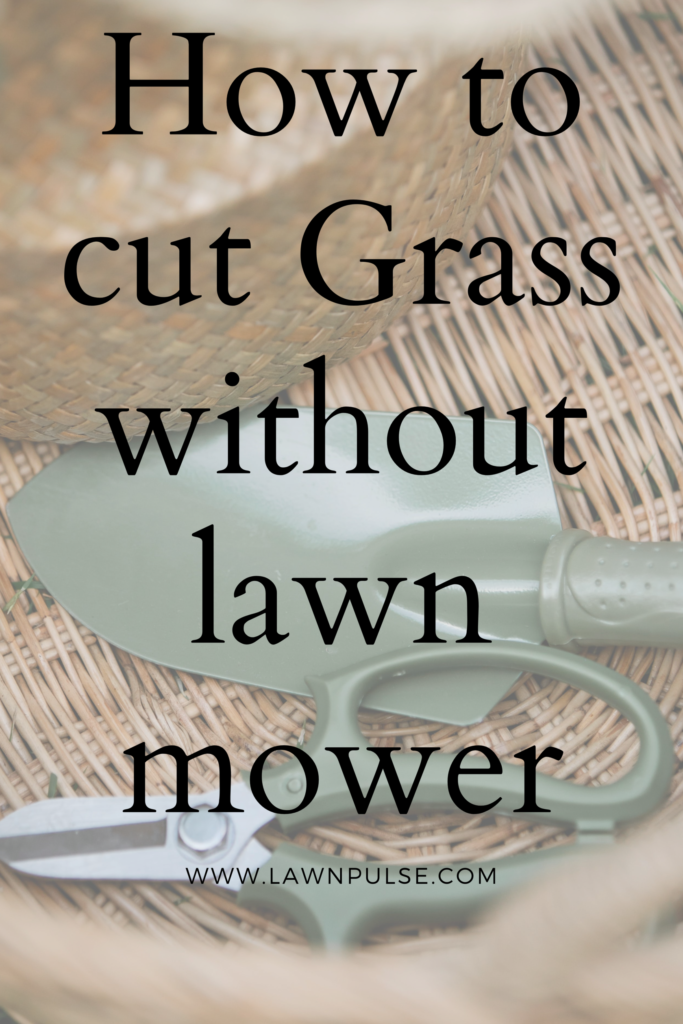Keeping a neat and tidy lawn is a task that many homeowners take seriously. However, not everyone owns a lawn mower hence why alternative must be made available to cut grass without lawn mower, and even those who do may encounter times when the mower is out of order or otherwise unavailable. In such situations, it’s important to know that there are alternative ways to cut grass. This informative article will outline several methods for cutting grass without a lawn mower, guiding you through the process and providing tips for achieving the best results.
Table of Contents:
- Scythe
- Hand Shears
- String Trimmer
- Sickle
- Garden hoe
Remember, safety is paramount when using any of these tools. Use the proper protective gear at all times, and adhere to the manufacturer’s instructions.
Each method has its own merits and drawbacks, operational requirements, and level of efficiency. By the end of this article, readers will be well-equipped with the knowledge and understanding of how to maintain their lawns even without the use of a lawn mower. So, let’s delve into the heart of the matter and explore these alternatives in detail.
Tools of the Trade: Essential Gear for Cutting Grass without a Mower
To effectively cut grass without a lawn mower, one must be equipped with the right tools. These tools will help in achieving a neat and well-manicured lawn, even without the conventional cutting machine. Here are the primary tools that one should have.
Scythe
A scythe is a traditional tool with a long, curved blade at one end and two short handles at the other. This instrument allows for a swinging motion to cut grass. The blade should always be kept sharp for optimal performance. The scythe is a valuable tool for cutting large areas of grass and handling tall or heavy growth.
The scythe, a traditional and versatile tool, has been used in various applications throughout history, particularly in agriculture. It offers a tangible and environmentally friendly way to maintain and manage grass. Nonetheless, similar to any tool, it possesses both advantages and disadvantages. Understanding these will help you determine if a scythe is the right tool to cut your grass when there is no lawn mower.

Pros of Using a Scythe
- Environmentally Friendly: Unlike power-driven lawn mower, scythes require no fuel or electricity. This makes them a more sustainable choice for those seeking to reduce their carbon footprint.
- Cost-Effective: With minimal maintenance cost and no need for fuel or electricity, using a scythe can be a cost-effective method over the long term.
- Quiet Operation: Scythes operate silently, ensuring that your grass cutting activities won’t disturb your neighbors or wildlife.
- Flexibility: Scythes can be used to cut grass in any direction and can handle tall or heavy grass better than most lawn mowers.
Cons of Using a Scythe
- Labor Intensive: Cutting grass with a scythe can be physically demanding, requiring good strength and stamina.
- Requires Skill: Effective use of a scythe requires practice and mastery. It’s not as straightforward as pushing a mower.
- Time Consuming: Depending on the size of the area, cutting grass with a scythe can be time-consuming compared to using a lawn mower.
- Dangerous if not Handled Properly: Scythes are sharp and can cause injury if not handled correctly. Safety is a paramount concern.
Note: Always remember to keep the blade of your scythe sharp for optimal performance. A dull blade not only makes the task more difficult but also increases the risk of injury.
Below is a summary of the pros and cons of using a scythe for cutting grass.
| Pros | Cons | |
|---|---|---|
| 1 | Environmentally friendly | Labor intensive |
| 2 | Cost-effective | Requires skill |
| 3 | Quiet operation | Time consuming |
| 4 | Flexibility | Dangerous if not handled properly |
Ultimately, the choice between using a scythe or a different tool to cut grass will depend on individual preferences, skills, and circumstances.
Grass Shears
Grass shears are like large scissors, which are particularly useful for trimming smaller areas of your lawn, and for shaping the edges. They come in two types: the edging shears, which have long handles and horizontal blades, and the hand shears, which work like a large scissors.

Pros and Cons of Grass Shears
Grass shears can be a valuable tool for lawn maintenance, particularly for those detailed trimming tasks. As with any tool, there are benefits and drawbacks to their use. Understanding these can help you make an informed decision about whether grass shears are a right fit for your lawn care routine.
| Pros | Cons |
|---|---|
|
|
Note: While grass shears are an efficient tool for precise trimming and shaping, they are not intended to replace a lawn mower for larger lawn care tasks. Consider your specific lawn care needs and physical capabilities before deciding to use grass shears.
String Trimmer
A string trimmer, or weed whacker, is a versatile tool that can cut grass and weeds in areas a mower can’t reach. It uses a monofilament line, or string, which rotates at a high speed to cut grass. The string trimmer is great for cutting grass near fences, trees, and garden beds.

Pros and Cons of a String Trimmer
While a string trimmer proves to be an asset for maintaining a well-groomed lawn, it comes with its own set of advantages and disadvantages. Understanding these can help you make an informed decision on whether to use it as an alternative to a lawn mower.
| Pros | Cons |
|---|---|
|
|
Sickle
A sickle is an ancient tool with a curved blade that can be used to cut grass. It’s ideal for small patches of grass and can also be used for harvesting crops. While using this tool, one needs to ensure the blade is sharp and used with caution as it can be dangerous.

Pros and Cons of Using a Sickle
Choosing a sickle as a tool for cutting grass is a decision that should be weighed with careful consideration. It’s important to understand the advantages and drawbacks associated with its usage. Let’s delve into an in-depth analysis of the pros and cons of using a sickle.
| Pros | Cons |
|---|---|
|
|
In essence, a sickle can be a practical tool for cutting grass in smaller areas without the need for electricity or petrol. However, it demands physical effort, is time-consuming and should be handled with care to ensure safety. It’s essential to weigh these factors before deciding to use a sickle.
Garden Hoe
A garden hoe is another tool that can be useful for cutting grass. It has a long handle and a broad blade at one end. The blade can be used to chop off the grass at the roots. It’s a handy tool for maintaining smaller lawns.

Pros and Cons of Using a Garden Hoe for Cutting Grass
Just like any other tool, a garden hoe has its own set of advantages and disadvantages when it comes to cutting grass. Here’s a detailed comparison:
| Pros | Cons |
|---|---|
|
|
In conclusion, a garden hoe can be a versatile and cost-effective tool for maintaining smaller lawns. However, it requires considerably more physical effort and time than a lawn mower, particularly for larger lawns or those with long grass. Therefore, the suitability of a garden hoe for cutting grass largely depends on the specific needs and physical capabilities of the user.
While each of these tools can help maintain your lawn without a mower, it’s important to remember that they require more physical effort than their motorized counterpart. However, with proper technique and regular maintenance, these tools can help you achieve a well-manicured lawn.
Conclusion
So, there you have it to effectively cut grass without a lawn mower. These are the ins and outs of maintaining a well-manicured lawn, even a lawn mower is not within your reach. It might require a little more elbow grease, but the results can be just as spectacular.
The key is in understanding the unique characteristics of each tool, mastering the correct technique of usage, and ensuring regular care. And remember, using these tools can also give you a good workout, so it’s a win in more than one ways.
Whether you’re using a scythe, a strimmer, or a pair of shears, you’re now equipped with the knowledge to keep your lawn looking its best.
It’s not about the tools you have; it’s about how you use them. So, don’t be discouraged if you don’t have a lawn mower. Embrace the tools you do have, and with a little effort, you can achieve a lawn that is the envy of your neighborhood.
Happy gardening!

